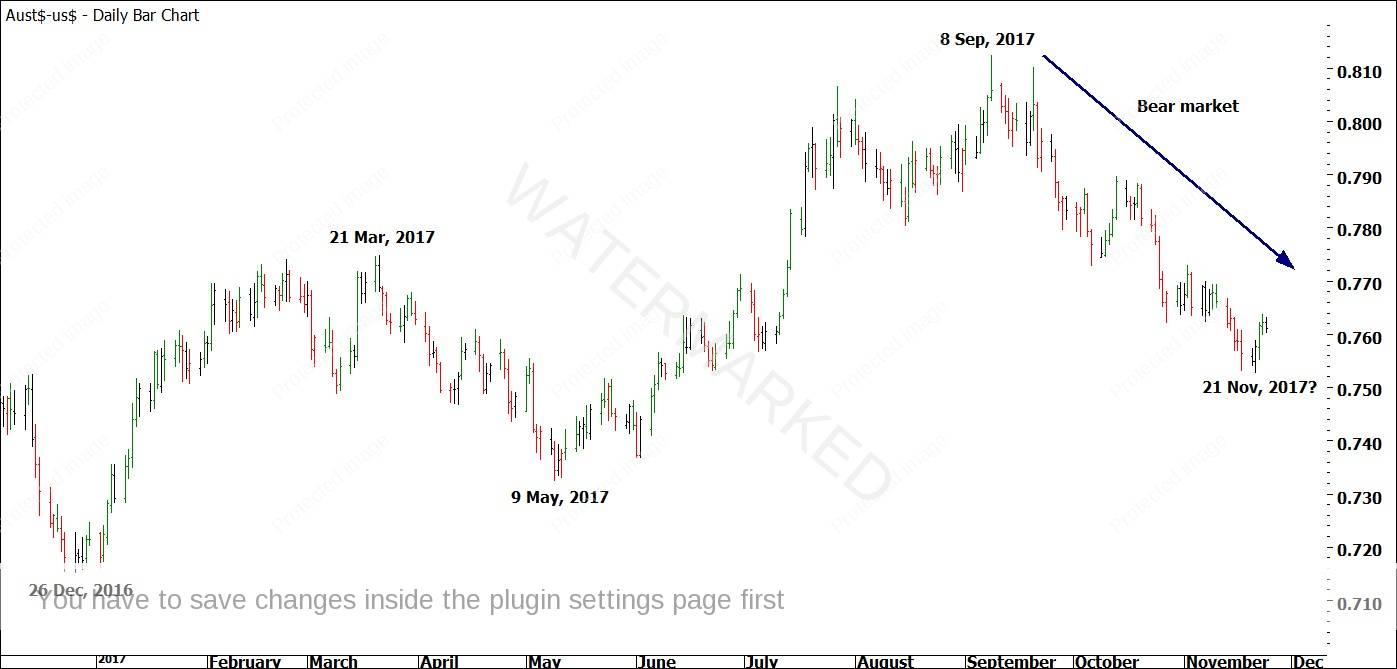A couple of months ago, I was looking for a low on the Australian Dollar (FXADUS in ProfitSource) to come in around the September Seasonal Date. I was feeling very confident that this low would ‘drop in’, having seen some excellent turns on the Australian Dollar, Canadian Dollar and the Euro over the past 12 months, using the exact same techniques. I expected a nice, juicy low to form on the Australian Dollar, to be followed by a nice strong run up into a high later in the year. For those who don’t follow the currencies, let’s take a look at September, 2017 on the Australian Dollar in Chart 1 below.
Now, this may seem arrogant to you, but I was actually quite surprised that I got this call wrong. I had entered the Australian Dollar (correctly!) very close to the December, 2016 and May, 2017 lows, which you can see in Chart 1. The shape of the market in July and August, 2017 was very similar to the Road Map I had discussed with students at the March, 2017 Master Forecasting Congress, a Road Map that had already given us both the May low and July top for the year so far. In other words, I felt very much ‘in sync’ with the market, and I had every reason to expect that the September low would occur.
So what happened? I could write a year’s worth of Platinum articles on that question, but all I will say is that the low did not come in. I was wrong. So as a trader, how should I deal with being wrong?
It is important not to look at trades in isolation. It is very easy to look at a losing trade and think that you have done something wrong. The key is to look at your trades as a group. If you are applying the same techniques over and over, looking for trades, and you have made several profitable trades in the past using this analysis, then you shouldn’t be too worried that a few trades here and there don’t work out. It happened to David Bowden, it happened to WD Gann, so there is no shame in it happening to you or me. If, on the other hand, your analysis rarely gives you good results, it’s time to examine how you are applying that analysis in the first place.
For me, I can look back and say that my analysis gave me the December, 2016 low and the May, 2017 low. They were great lows, each returning a double-digit (10 or above) Reward to Risk Ratio. Now when you look at the September low being wrong, even if you have had a few losses, it doesn’t look so bad. Imagine you risk $1,000 per trade, and you have two losses. That’s $2,000. Some would choose to focus on that $2,000 loss. However, if you multiply that $1,000 by a double-digit Reward to Risk Ratio on two previous trading campaigns on that market, then all of a sudden, $2,000 looks pretty small.
I would encourage students to compile a list of their top 5 best trades and their top 5 worst trades. Examine all of the characteristics of your best trades and seek to replicate them in your future trades. Then, look at all the characteristics of your worst trades, and aim to avoid them in the future.
In summary, even though I was wrong on the September trade, I have seen enough excellent trades come together to make me stick with my trading analysis. To me, David’s techniques are the best I have seen, and I have been in the markets for a long time. When I am right, the trades are fantastic, generally giving double-digit returns on my risk! When I am wrong, I lose one or two ‘units of risk’. I have no intention of abandoning my strategies because of an incorrect forecast!
I will finish by saying that not all trades are equal. However, I encourage you to make sure that all of your trades LOOK equally good! As Aaron Lynch used to say to me, ‘there are so many good looking trades out there, why would you take an average looking one?’
Be Prepared!
Mathew Barnes
